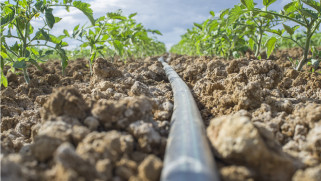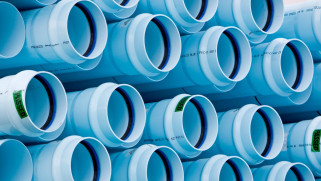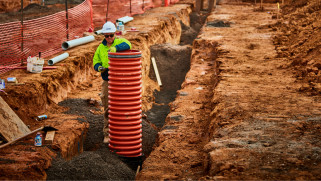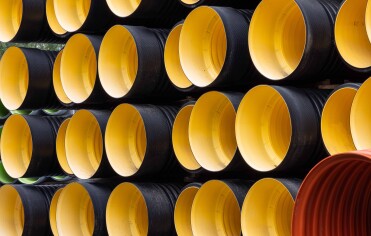Proper jointing is critical to a PVC pipeline's performance, and lubricant plays a key role in that process. The correct use of lubricant can significantly influence the integrity, longevity and efficiency of a PVC installation. We’ll explore the purpose of PVC lubricants, their role in joint integrity, and best practices for effective and compliant use.
What is PVC Lubricant?
PVC lubricant is a purpose-formulated compound used to assist in the assembly of PVC pipes and fittings. Its primary function is to reduce friction between the spigot and socket during insertion, ensuring a smooth and damage-free connection.
There are multiple types of lubricants used in PVC joining:
- Water-based lubricants – Commonly used for their ease of application, environmental friendliness, and suitability for potable water systems.
- Silicone-based lubricants – Known for their durability and performance in high-pressure or high-temperature environments.
Unlike general-purpose lubricants, PVC-specific lubricants are designed to be chemically compatible with both PVC and elastomeric materials. This compatibility is essential to prevent degradation of rubber ring seals and to maintain joint integrity.
Note: Under AS/NZS 2032:2006 – Installation of PVC Pipe Systems, lubricants must be non-toxic, not support microbial growth, and be safe for use in drinking water applications.
Why is lubricant essential for PVC joining?
Using the correct lubricant is essential for achieving a secure and compliant joint. Its benefits include:
- Friction reduction: Lubricant allows the pipe to slide into the fitting without excessive force, preventing damage to the pipe ends or rubber seals.
- Accurate alignment: Proper lubrication helps ensure the joint is seated correctly, reducing the risk of misalignment and leaks.
- Seal preservation: Minimising stress on rubber components during installation can help extend their service life.
- Installation efficiency: Lubricant simplifies the joining process, particularly in large-scale or time-sensitive projects.
What happens if you don’t apply it properly?
Incorrect application can result in:
- Joint misalignment: Uneven or insufficient lubrication may prevent the pipe from seating fully.
- Seal damage: Overuse or use of incorrect lubricants can degrade rubber rings.
- Leaks and failures: Poorly lubricated joints can be more prone to leakage and long-term performance issues.
How to properly apply PVC lubricant
To help ensure a secure and leak-free joint follow these steps:
- Clean the surfaces: Remove any dirt, dust, or debris from the pipe spigot and socket or coupling.
- Apply lubricant: Use a brush or gloved hand to fully cover the circumference up to the witness mark, ensuring that the lubricant also covers the pipe chamfer.
- Insert the pipe: Push the spigot into the socket and push home with a steady, controlled motion until the witness mark remains just visible.
Best practices:
- Use only lubricants approved for use with PVC and elastomeric seals.
- Avoid petroleum-based products, which can degrade rubber components.
- Keep the lubricant container closed when it’s not in use to avoid spillage or contamination by dust or dirt.
- Do not apply lubricant to damaged or contaminated seals.
Choosing the right PVC Lubricant for your project
When selecting a lubricant, consider the following factors:
- Material compatibility: Ensure the lubricant is suitable for both PVC and rubber ring seals.
- Standards compliance: Choose products that meet AS/NZS 2032 Installation of PVC-U Pipe Systems and are certified for potable water use.
- Environmental impact: Water-based lubricants are typically more sustainable due to their non-toxic, biodegradable composition and minimal environmental residue. These properties make them safer for potable water systems and and easier to clean up.
PVC Pipe Lubricant FAQs
What is the best lubricant for rubber and plastic?
Water-based or silicone-based lubricants specifically formulated for PVC joining are recommended.
Is pipe lubricant necessary?
For Iplex rubber ring joints, yes. It ensures proper joint assembly, prevents damage, and supports long-term pipeline performance.
Is PVC lubricant necessary for all pipe joints?
It is essential for rubber ring joint systems. Solvent-welded joints do not require lubricant.
Can I use household lubricants like petroleum jelly instead?
No. Petroleum-based products can degrade rubber and plastic, leading to joint failure.
Does PVC lubricant affect water quality in plumbing systems?
Only if the wrong type is used. Always choose a lubricant certified for potable water systems.
How much lubricant should be applied to a PVC joint?
Apply a thin, even layer—enough to coat the surfaces without excess buildup.
To explore about Iplex PVC lubricants, visit https://www.iplex.com.au/products/additional-products/lubricant/ today.







